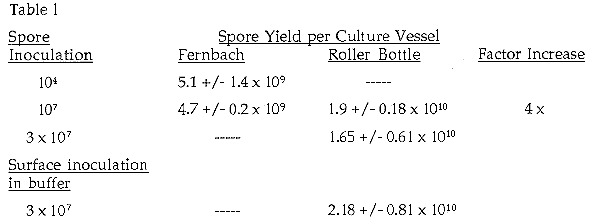A convenient and safe method to generate a large quantity of Aspergillus parasiticus spores.
In order to examine the spore pigments in strains of Aspergillus parasiticus, we
developed a method to safely generate a large quantity of spores while conserving laboratory
space, resources, and time.
Traditional methods employed to generate stock supplies of spores usually involve
inoculating the surface of nutrient agar, in a flask or petri dish, with a defined number of
spores (Pontecorvo et al. 1953. Adv. Gen. 5:141-238). The culture is placed at 30 C for 48
hrs to encourage mycelial growth then moved to room temperature. Asexual sporulation
is evident after an additional two days with a maximum number of spores generated by ten
days. The traditional vessels used for large scale spore production are 2.8 liter Fernbach
flasks (surface area-SA = 285 cm2) and 15 cm petri dishes (SA = 175 cm2). Spores are
harvested by placing buffer in the flask or dish and gently scraping the agar surface with a
long handled glass rod. Initially the hydrophobic spores are difficult to wet and repeated
mechanical agitation is required to harvest them. Finally, the spore suspension is collected,
washed, and concentrated by centrifugation. During the protracted scraping step, spores can
escape from the vessel thereby increasing the chances of laboratory contamination and
human exposure to a concentrated spore inoculum. The method we describe eliminates the
scraping step and employs easily stacked, reusable, non-breakable plastic containers with
three times the surface area of a Fernbach flask. We feel that the risk of releasing a large
quantity of spores while harvesting is greatly reduced.
Two liter, polystyrene Corning Roller Bottles (RBTL - catalogue number = 25240)
are inoculated with 10(7) spores in 200 mls of 3% YGT agar (yeast extract 0.5%, glucose 2%, and trace elements) at 50 C using standard sterile technique. The caps are replaced, and
the bottles rolled steadily in an ice bath until the agar has solidified along the inner surface
(3 to 5 minutes). The caps are then replaced with sterile foam plugs to allow gas exchange
and incubated as described above. The bottles may be placed in a vertical position or
conveniently stacked on their sides during mycelial growth and sporulation. Normal mycelial
growth initially proceeds within the agar and eventually breaks through the surface where
asexual sporulation occurs. The spores are harvested by placing 200 mls of buffer inside the
vessel, replacing the original plastic cap, and shaking vigorously. The spore solution is
decanted, concentrated by low speed centrifugation, and washed in storage buffer. The
spores are almost entirely free of contaminating mycelial debris and agar fragments.
Although inoculating pre-poured RBTLs with a spore solution may seem more
convenient, the harvesting procedure is compromised in two ways. An additional filtration
step is required to remove debris that is released from the mycelial mat growing on the agar
surface, and bits of agar frequently plug the filters. When spores are inoculated with the
molten agar, mycelial filaments infiltrate and effectively reinforce it. A surface mycelial mat
leaves the agar fragile and susceptible to the shear forces required to wet the spores.

Table 1 indicates typical spore yields from Fernbachs and RBTLs inoculated with
a variable number of spores. The initial spore inoculum did not play a statistically
significant role in the final number of spores generated per flask or RBTL. The number
of spores generated was roughly proportional to the available surface area.
In summary, the described procedure has a number of benefits over conventional
methods for generating large quantities of spores. It is safer due to the unbreakable nature
of plastic RBTLs and because spore harvesting can be done in a completely closed
container. In addition, the RBTLs save space since they have approximately 3X the usable
surface area compared to Fernbach flasks and they can easily be stacked on their side on
a shelf.
